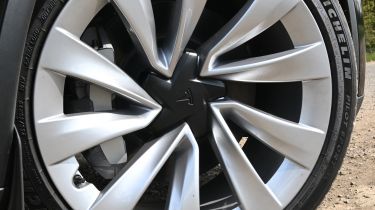Tesla Model Y: performance, motor & drive
The updated Model Y is still ridiculously quick, but there are big improvements to be found elsewhere, too
| 0-62mph | Top speed | Driven wheels | Power |
| 5.6s | 125mph | Rear | N/Abhp |
| 5.4s | 125mph | Rear | N/Abhp |
| 4.6s | 125mph | Four | N/Abhp |
Teslas rarely disappoint in a straight line, and the updated Model Y does nothing to tarnish that reputation. While Tesla doesn’t quote output figures for its motors, the regular Rear-Wheel Drive car has enough punch to overcome its two-tonne kerbweight for a 5.6-second 0-60mph time, while the Long Range car goes two tenths quicker, and thanks to its extra power and traction, the Long Range All-Wheel Drive covers the same acceleration metric in 4.6 seconds. All have a 125mph limiter at the top end.
More significantly, the latest Model Y is better at all the things that don’t just involve ramming your right foot into the carpet. Where the old car could be stiff and unrefined, and its steering overly darty and devoid of feel, the latest model is much smoother over bumps, feels better insulated from wind and road noise, and has calmer steering (even if feedback remains notable by its absence).
One thing that might take a little getting used to, at least at first, is utilising swipe gestures on the touchscreen to select drive, reverse, or park, rather than the old column stalk. Tesla’s retained the indicator stalk though so you don’t need the touchscreen or to speak an incantation to tell other traffic which direction you’re going.
Tesla’s Autopilot feature remains an option, and as an assistant for motorway driving, does make things a little more relaxed – with the caveat that the Model Y is still far from being an autonomous vehicle, despite the occasional claim to the contrary.
